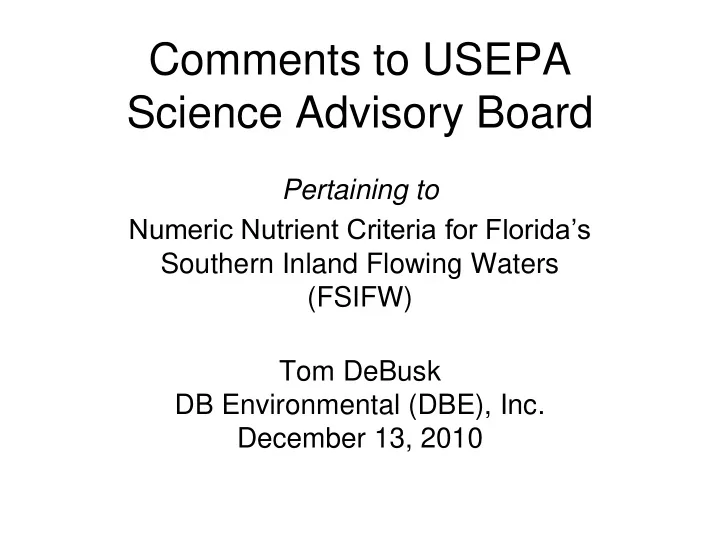

Comments to USEPA Science Advisory Board Pertaining to Numeric Nutrient Criteria for Florida’s Southern Inland Flowing Waters (FSIFW) Tom DeBusk DB Environmental (DBE), Inc. December 13, 2010
Overview • SAB Charge, with respect to numeric criteria for FSIFW: – Data sources appropriate? – Assessment endpoints appropriate? – Compare reference conditions and stressor response • Existing data demonstrate: – Macroinvertebrates in south Florida canals are constrained by habitat and flow characteristics, and show lack of response to nutrients – Chlorophyll not an appropriate response variable for nutrients, especially in EAA canals, due to high color – Despite marked variability in water quality (with respect to color, chlorophyll and nutrients) among S. FL canals, excellent fisheries are common
Decades-long macroinvertebrate monitoring program in natural and channelized streams in central Florida Legend Interstate - 4 Bonnet Creek Stream Channel Stream Channel Permitted County Line County Line Discharge of Highway Highway Treated Effluent Monitoring Stations Orange Co. Osceola Co. Flow Flow US-192 RC-12 Water Chemistry Water Chemistry C-12 Macroinvertebrate Macroinvertebrate Reedy Channelized stream 0 2 4 6 8 10km Creek RC-14 Natural stream
Natural stream (RC-14) >>> <<< Channelized stream (C-12)
400 Abundance 300 (Individuals per 200 Artificial Substrate) 100 0 50 40 30 Total Taxa Richness 20 10 0 20 15 Florida Biotic Index 10 5 Macroinvertebrate metrics 0 <100 <100 100-200 200-400 as a function of water C-12 RC-14 column TP (ug/L) & channelized natural stream type
DBE and FDEP canal macroinvertebrate sampling stations FDEP Forested Creek FDEP Canal Site DBE Canal Site
DBE and FDEP macroinvertebrate metrics (Stream Condition Index [SCI]) from canal sampling sites No evidence of biological community improvement across range of TP concentrations FDEP sampling DBE sampling 100 Exceptional SCI Score 80 Healthy 60 40 Impaired 20 0 0.000 0.100 0.200 0.300 0.400 0.500 0.600 0.700 0.000 0.100 0.200 0.300 0.400 0.500 0.600 0.700 Grab Sample Total P (mg/L) 6-month Total P (mg/L)
FDEP’s “Benchmark Streams” exhibit much higher SCI scores than canals. However, even in these systems with favorable habitats the relationship with TP is weak 100 Exceptional FDEP Canal Sampling DBE Canal Sampling 80 SCI Score FDEP Benchmark Streams Healthy 60 40 Impaired 20 0 0 200 400 600 800 Grab Sample Total P (µg/L)
Indian Prairie Canal Removal of shoreline vegetation between DBE’s 1 st Qtr (left) and 3 rd Qtr (below) sampling events In south Florida, poor canal habitat is exacerbated by management for floodwater conveyance
2007 Lakes Data DB Canal Survey 250 Chlorophyll a (µg/L) 200 150 100 50 0 0 100 200 300 0 1 2 3 4 5 TN (mg/L) TP (µg/L) Relationships between nutrients and chlorophyll concentrations in south Florida canals (N=14) are compared to water quality in 48 Florida lakes during 2007 (FWC 2008, using Lakewatch water quality data).
Three S. Florida canal sites have different water clarity and markedly different TN and TP levels, but all support excellent fisheries. Differences in clarity are related to color, not chlorophyll or nutrient levels. S-177 TN - 0.71 mg/L TP - 7 µg/L Chl. a - 2.7 µg/L Brow003 TN - 1.16 mg/L TP - 123 µg/L Chl. a - 5.4 µg/L WPB East TN - 4.02 mg/L TP - 98 µg/L Chl. a - 4.7 µg/L
South Florida is dominated by canals, so the unique characteristics of these systems (poor macroinvertebrate assemblages; varied and often poor relationships between chlorophyll and nutrients; good fisheries) must be addressed when establishing FSIFW nutrient criteria
Recommend
More recommend